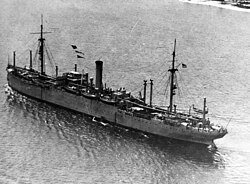Anhalt (ship, 1914)
|
||||||||||||||||||||||||
|
||||||||||||||||||||||||
|
||||||||||||||||||||||||
|
||||||||||||||||||||||||
The Anhalt was one of the eight Rhineland-class freighters of North German Lloyd (NDL) completed by Bremer Vulkan for service on the freight line to Australia around the Cape of Good Hope . In 1914 she was in the Dutch East Indies launched . She had to be extradited after the end of the war and first served in the British and in 1922 in Spanish service. In 1925 the NDL bought them back and deployed them to East Asia .
In 1932 the Anhalt was sold to the Soviet Union . 1941 in the Black Sea scuttled , it was lifted by the Germans as a Boy Feddersen brought back on track. After a torpedo hit , the ship sank on August 11, 1943.
Mission history
The Anhalt came into service on March 20, 1914 as the seventh ship of the class and the last before the outbreak of the First World War. She could not finish her maiden voyage because of the outbreak of the First World War . After reaching Australia, she was on her way back through the Dutch East Indies. She was interned on August 24, 1914 in Telok Betong on Sunda Strait and remained there for the duration of the World War.
The Anhalt came under the British flag by extradition to the victorious powers in 1919 and was managed by British India Steam Navigation; In 1921 the management of the ship changed to H. Hogarth & Sons, Androssan. In 1922 it was sold to Spain and renamed Aya Mendi . On January 23, 1925, the NDL bought back its former ship and used it again as a stop .
The Anhalt was the second ship in the Rhineland class that came back into service with Norddeutscher Lloyd after the First World War, which had bought back Dessau , which was completed in Flensburg during the war , from Great Britain in October 1924 in order to use it on the East Asian route. The Anhalt was also deployed on this route and began its first journey in the spring of 1925. The new high-speed freighters coming into service and the economic and shipping crisis of the early 1930s quickly made the two freighters redundant.
While the Dessau on May 1, 1933 launched and then was scrapped in 1935, the NDL was able Anhalt on 18 November 1932 in the Soviet Union sell. The NDL managed to sell a total of 12 ships with a total of 58,596 GRT, which were later followed by more. The Anhalt was the second largest of these ships and was one of the six ships whose new home port was Odessa .
In the Soviet Union, the Anhalt was renamed Kharkov and used on the Black Sea and from there to East Asia. During the advance of the German Wehrmacht in 1941, it was sunk in Nikolajew itself , but was lifted and repaired by the Germans and put back into service as Boy Feddersen for the Schwarzmeer-Schiffahrts-GmbH , whose largest cargo ship it was. The ship was named after the sea transport chief of the Black Sea who fell in April 1943, Captain Boy Feddersen.
On August 10, 1943, the Soviet submarine D 4 torpedoed the former NDL freighter west of the Crimea, which had already been damaged by aircraft . The following day the Boy Feddersen sank while trying to tow the ship to safety.
Wreck investigation
In April 2017, the wreck of the freighter Boy Feddersen was found by Russian deep divers west of the Crimea , between Sevastopol and Cape Tarchankut . In June 2017, the ten-day wreck investigation began from the dive support ship Meteor . During the expedition it was discovered that the ship was not carrying chemical weapons or explosives , but that it had tractors and Mercedes-Benz trucks on board.
Renewed use of the name
As early as 1936, the NDL received another ship with the name Anhalt , when the freighters taken over with the Roland Line in 1926 were given typical NDL names. The Ansgir (5870 GRT), completed in 1922 by the Germania shipyard , was renamed Anhalt . Her sister ship Wido was also given a Rhineland class name with Dessau .
The second stop of the NDL was stranded at Stadlandet after an attack by British destroyers on December 27, 1941 . It could no longer be repaired and was scrapped.
literature
- Arnold Kludas : The ships of the North German Lloyd 1857 to 1919 . Koehlers Verlagsgesellschaft, Herford 1991, ISBN 3-7822-0524-3 .
- Jürgen Rohwer , Gerhard Hümmelchen : Chronicle of the Naval War 1939-1945 , Manfred Pawlak VerlagsGmbH (Herrsching 1968), ISBN 3-88199-009-7
- Reinhart Schmelzkopf: German merchant shipping 1919–1939 . Verlag Gerhard Stalling, Oldenburg, ISBN 3-7979-1847-X .
- Otto J. Seiler: Australienfahrt , ES Mittler & Sohn, Herford 1988, ISBN 3-8132-0270-4 .
Web links
Footnotes
- ↑ Aya Mendi SS (1921 ~ 1925) Boy Federsen SS (+1943)
- ↑ a b c Kludas, NDL Seeschiffe 1857-1919, p. 142.
- ↑ Kludas, NDL Seeschiffe 1857-1919, p. 144.
- ↑ melt head, p. 157
- ^ Rohwer, p. 363
- ↑ Sinking the Boy Federsen
- ↑ sinking of the Anhalt
